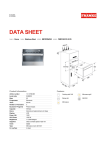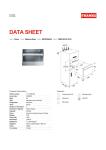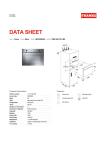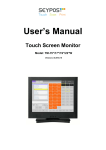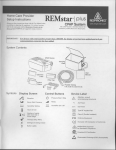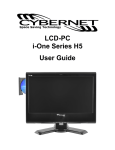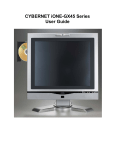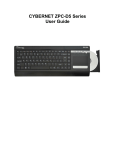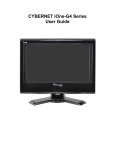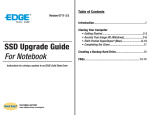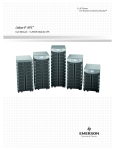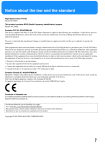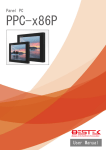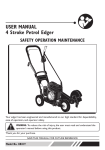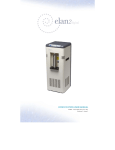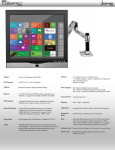Download User Manual - Howard Computers
Transcript
CyberMed H19 Series User Guide FCC-B Radio Frequency Interference Statement This equipment has been tested and found to comply with the limits for a class B digital device, pursuant to part 15 of the FCC rules. These limits are designed to provide reasonable protection against harmful interference in a residential installation. This equipment generates, uses and can radiate radio frequency energy and, if not installed and used in accordance with the instruction manual, may cause harmful interference to radio communications. However, there is no guarantee that interference will not occur in a particular installation. If this equipment does cause harmful interference to radio or television reception, which can be determined by turning the equipment off and on, the user is encouraged to try to correct the interference by one or more of the measures listed below. • Reorient or relocate the receiving antenna. • Increase the distance between the equipment and receiver. • Connect the equipment into an outlet on a circuit different from that to which the receiver is connected. • Consult the dealer or an experienced radio/television technician for help. Notice 1 The changes or modifications not expressly approved by the party responsible for compliance could void the user's authority to operate the equipment. Notice 2 Shielded interface cables and A.C. power cord, if any, must be used in order to comply with the emission limits. Trademarks All trademarks are the properties of their respective owners. Intel® is a registered trademarks of Intel Corporation. PS/2 and OS®/2 are registered trademarks of International Business Machines Corporation. Windows® 7/Vista/XP/NT/2000/98/95 are registered trademarks of Microsoft Corporation. Netware® is a registered trademark of Novell, Inc. Award® is a registered trademark of Phoenix Technologies Ltd. AMI® is a registered trademark of American Megatrends Inc i Safety Instructions 1. 2. 3. 4. 5. 6. 7. 8. 9. 10. 11. 12. 13. 14. 15. Always read the safety instructions carefully. Keep this equipment away from humidity. Lay this equipment on a reliable flat surface before setting it up. The openings on the enclosure are for air convection hence protect the equipment from overheating. DO NOT COVER THE OPENINGS. Confirm the voltage of the power source and adjust accordingly to 110/220V before connecting the equipment to the power inlet. Place the power cord in such a way that it cannot be stepped on. Do not place anything over the power cord. Always unplug the Power Cord before inserting any add-on card or module. All cautions and warnings on the equipment should be noted. Never pour any liquid into the opening. This will cause damage and/or electrical shock. Do not disable the protective grounding pin from the plug. The equipment must be connected to a grounded main socket/outlet. The Optical Storage devices are classified as Class 1 Laser products. Use of controls or adjustments or performance of procedures other than those specified is prohibited. Do not touch the Laser lens inside the optical storage drive. When installing the coaxial cable to the TV Tuner, it is necessary to ensure that the metal shield is reliably connected to a protective earthing system of the building. Cable distribution systems should be grounded (earthed) in accordance with ANSI/NF PA 70, the National Electrical Code (NEC ), in particular, Section 820.93, Grounding of Outer Conductive Shield of a Coaxial Cable. If any of the following situations arise, have the equipment checked by authorized service personnel: • The power cord or plug is damaged. • Liquid has penetrated into the equipment. • The equipment has been exposed to moisture. • The equipment has not worked well or you cannot get it working according to the User's Guide. • The equipment has been dropped and damaged. • The equipment has obvious signs of breakage. Do not attempt to remove or upgrade any components by yourself, any installation or modification should be conducted by service personnel. DO NOT LEAVE THIS EQUIPMENT IN AN UNCONDITIONED ENVIRONMENT WITH A STORAGE TEMPERATURE ABOVE 50° C (122°F). IT MAY DAMAGE THE EQUIPMENT. CAUTION: Danger of explosion if battery is incorrectly replaced. Replace only with the same or equivalent type recommended by the manufacturer. ii WEEE Statement (Waste Electrical and Electronic Equipment) The WEEE directive places an obligation on EU-based manufacturers, distributors, retailers and importers to take-back electronics products at the end of their useful life. A sister Directive, ROHS (Restriction of Hazardous Substances) compliments the WEEE Directive by banning the presence of specific hazardous substances in the products at the design phase. The WEEE Directive covers products imported into the EU as of August 13, 2005. EU-based manufacturers, distributors, retailers and importers are obliged to finance the costs of recovery from municipal collection points, reuse, and recycling of specified percentages per the WEEE requirements. Instructions for disposal of WEEE by Users in the European Union The symbol shown below is on the product or on its packaging, which indicates that this product must not be disposed of with other waste. Instead, it is the user’s responsibility to dispose of their waste equipment by handing it over to a designated collection point for the recycling of waste electrical and electronic equipment. The separate collection and recycling of your waste equipment at the time of disposal will help to conserve natural resources and ensure that it is recycled in a manner that protects human health and the environment. For more information about where you can drop off your waste equipment for recycling, please contact your local city office, your household waste disposal service or where you purchased the product. iii TABLE OF CONTENTS FCC-B Radio Frequency Interference Statement ........................................................ i Trademarks ..................................................................................................................... i Safety Instructions ........................................................................................................ ii WEEE Statement .......................................................................................................... iii Introduction ................................................................................................................... 1 CyberMed H19 Series Specifications .......................................................................... 1 Processor Support .................................................................................................................. 1 Chipset..................................................................................................................................... .1 Memory Support ...................................................................................................................... 1 Networking ............................................................................................................................... 1 Audio......................................................................................................................................... 1 Hard Disk Drive ........................................................................................................................ 2 Mounting................................................................................................................................... 2 Swivel Stand............................................................................................................................. 2 LCD Panel ................................................................................................................................. 2 Expansion Slots ....................................................................................................................... 2 Front Lower Right Bezel ......................................................................................................... 2 Right Side Bezel....................................................................................................................... 2 Left Side Bezel ......................................................................................................................... 2 Bottom I/O Panel ..................................................................................................................... 2 Power Supply ........................................................................................................................... 2 Dimensions .............................................................................................................................. 2 Power Management....................................................................................................... 7 Waking the System Up ............................................................................................................ 9 Energy Saving Tips ................................................................................................................. 9 CyberMed H19 Series Overview ................................................................................. 10 On Screen Display Buttons .................................................................................................. 13 On Screen Display Usage ..................................................................................................... 14 System Assembly........................................................................................................ 17 Necessary Tools .................................................................................................................... 17 Orientation of Key Parts........................................................................................................ 18 CyberMed H19 Disassembly ................................................................................................. 19 Installing the CPU .................................................................................................................. 22 iv Installing the CPU Heat Sink................................................................................................. 23 Installing the Memory Module DDR3 SO-DIMM .................................................................. 24 Installing the Hard Disk Drive ............................................................................................... 25 Installing the Mini-PCIe Card (Optional) .............................................................................. 26 Installing the Cover ............................................................................................................... 27 Cybernet E-Recycling SOP……………………………………….………………………………29 Figures Figure 1: Front View ................................................................................................... 10 Figure 2: Left side view .............................................................................................. 11 Figure 3: Power Button and USB Ports ..................................................................... 12 Figure 4: Touch Panel ................................................................................................. 12 Figure 5: IrDA Receiver for TV Tuner ........................................................................ 12 Figure 6: Back view ..................................................................................................... 15 Figure 7: Bottom Panel I/O Ports ............................................................................... 15 Figure 8: System Ventilation Fan ............................................................................... 16 Figure 9: Heat Sink Ventilation, System Ventilation and Stand .............................. 16 Figure 10: ..................................................................................................................... 18 System Fan and Ventilation ............................................................................. 18 HDD ................................................................................................................... 18 Heat Sink, Memory Modules, Mini-PCIe and Touch Panel Control. ............. 18 Figure 11: Open system with GPU ........................................................................... 20 Figure 12: Open system without GPU ...................................................................... 21 v Introduction Congratulations for purchasing the CyberMed H19. The CyberMed H19 Series is your best Slim LCD PC choice. With the fantastic appearance and small form factor, it can easily be set anywhere. The feature packed platform also gives you an exciting PC experience. CyberMed H19 Series Specifications Processor Support The 2nd generation Intel® Core™ i3, i5 and Core™ i7 in the 1155 package up to 65W. Motherboard Core Logic Intel® H61 Express chipset (Sandy Bridge) Memory Support DDR3 1066/1333 MHz SO-DIMM SDRAM (Un-buffered Non-ECC) 2 DDR3 1333 MHz SO-DIMM slots (8GB Max) Video & Graphics for H19 Intel® integrated H61 Chipset with Intel® HD Graphics Intel GMA HD/Intel Clear Video HD Technology Built-in support for 1080p HD video playback, HDMI 1.4 & Blu-ray 3D support Supports Microsoft® DirectX 10.1, Shader Model 4.0 and OpenGL 3.0. DVMT allocated as needed from 128MB to 1.70GB Maximum display resolution 2560 x 1600. Video & Graphics for H19G Onboard NVIDIA GeForce GT 540M(630M) GPU 1.0GB sDDR3 128-bit RAM 1080p HD video playback, HDMI 1.4 & Blu-ray 3D support. Supports Microsoft® DirectX 11, Shader Model 5.0 and OpenGL 4.1 Maximum display resolution 2560 x 1600. Networking Supports 2 PCI Express LAN 10/100/1000 Fast Ethernet by Realtek RTL8111E Audio 2 internal speakers with 78dB+/-3dB @ 3W, 1 mic HD Audio Codec Realtek® ALC892 Flexible 10-channel audio with jack sensing Compliant with Azalia 1.0 Spec CyberMed H19 Product Orientation Page 1 Hard Disk Drive One 3.5” SATA Hard Disk Drive - Any Capacity Wall Mount Support 75x75 / 100x100 VESA mounting hole. Swivel Stand System Base enables left/right rotation up to 60 degrees. Tilt from -5 to 60 degrees LCD Panel 19" TFT LCD/LED panel screen 4:3 format display. Expansion Slots 2 mini-PCIe (One full size and one half size) Front Lower Right Bezel On Screen Display Buttons Volume Adjust Brightness Adjust Contrast Adjust Mute/Exit Menu/Enter Right Side Bezel 1 power button 2 USB 2.0 ports (for mouse and keyboard) Left Side Bezel 1 optical disk drive – 2.5” slim Bottom I/O Panel 1 DC/IN port, 1 Serial port, 1 DVI-I port, 1 HDMI port, 2 LAN RJ-45 jack, 2 USB 3.0 ports, 2 USB 2.0 ports, 1 LPT port (Optional), 3 Audio jacks – Line in, Line Out and Mic 4 TV Tuner ports - - Optional with TV Tuner (COAX Cable In, RCA Composite Video In, Audio Left & Audio Right), 1 CMOS clear button, 1 Reset button Power Supply 135 Watt Power Adapter, AC Input: 100~240V ~, 1.6-0.8A, 47-63Hz. DC Output: 135W MAX, 18-19V, 7.5A only Dimensions 47.5cm (H) x 43cm (W) x 25.5cm (D) (with stand) CyberMed H19 Product Orientation Page 2 Intended use The CyberMed H19 Series is intended to serve as a medical monitor which is designed for general purpose for hospital environment and for diagnosis. It could be used for Radiology, PACS (Picture Archiving Communication Systems), LIS (Lab Information Systems) and Electronic Medical Record purpose. It shall not be used for life-supporting system. WARNING: Critical diagnostic decision must not be based solely on images displayed by this device. Unpacking After opening the carton, there is a medical LCD PC with an accessory box. Check carefully to see if there are any damages or missing parts. Read the Manual Please read this manual carefully and remember to keep this manual for future reference. Safety Instructions & Cleaning This product has undergone various tests in order to comply with safety standards. Inappropriate use or open the housing may be dangerous. Please remember to follow the instructions below to ensure your safety during the installation and operating process. Transporting & Placement of unit 1. When moving the unit on a cart; be very cautious. Quick stops, excessive forces and uneven surfaces may cause the cart to overturn thus risking the unit to fall to the ground. 2. If the medical LCD PC unit does fall to the ground, immediately turn the power off and disconnect cords. Then contact a service technician for repairs. Continual use of the unit may result cause a fire or electric shock. Also, do not repair the unit on your own. 3. Having two or more people transporting the medical LCD PC unit is recommended. In addition, when installing the unit by suspending it also requires two or more people. 4. Before suspending the unit, make sure the material used for suspension is sturdy and stable. If not properly suspended, the medical LCD PC unit may fall and cause serious injury to people standing nearby as well as to the unit itself. 5. If the user wishes to mount the medical panel PC unit, remember to use only the mounting hardware recommended by the manufacturer. CyberMed H19 Product Orientation Page 3 Electrical and Power Source Related 1. This medical LCD PC unit must operate on a power source as shown on the specification label. If you are not sure what type of power supply used in the area, consult your dealer or local power supplier. 2. The power cords must not be damaged. Applied pressure, added heat, and tugging may damage the power cord. 3. The power cord must be routed properly when setup takes place. We advise that this aspect measure is to prevent people from stepping on the cords or while the unit is suspended to prevent flying objects from getting tangled with the unit. 4. Do not overload the AC outlets or extension cords. Electrical shocks or fires may occur from overloading. 5. Do not touch the power source during a thunderstorm. 6. If your hands are wet, do not touch the plug. 7. Use your thumb and index finger, grip firmly on the power cord to disconnect from the electrical socket. By pulling the power cord, may result in damaging it. 8. If the unit is not going to be in use for an extended period of time, remember to disconnect the unit. 9. The medical LCD PC unit uses 19V DC output from an adapter. Connect the unit to a power source with the same numerical value as indicated. Please use only the power cord provided by the dealer to ensure safety and EMC compliance. WARNING: To avoid risk of electric shock, this equipment must only be connected to a supply mains with protective earth Various Factors of Environment 1. Operating Temperature: 0°C to 50°C ; Non-operating temperature: 20°C to 60°C. 2. Operating Humidity (Non-Condensing): 10% to 90%. Non-operating Humidity (Noncondensing): 10% to 90%. 3.Do not insert objects into the openings. 4. Do not have liquids seep into the internal areas of the medical LCD PC unit. 5. Having liquids seep in or inserting objects into the unit may result in electric shocks from taking and/or short circuiting the internal parts. CyberMed H19 Product Orientation Page 4 6. Do not place the medical LCD PC unit in the presence of high moisture areas. 7. Do not install the medical LCD PC unit in a wet environment. 8. Do not place unit near heat generating sources. 9. Do not place the unit in a location where it will come in contact with fumes or steam. 10. Remember to keep the medical LCD PC unit away from the presence of dust. 11. If water has flow in or seep in, immediately disconnect the open frame unit. Then contact a service technician for repairs. Ventilation Spacing 1. Do not cover or block the openings on the top and back sides of the medical LCD PC unit. Inadequate ventilation may cause overheating thus reducing the lifespan of the unit. 2. Unless proper ventilation is present, do not place unit in an enclosed area; such as a built-in shelf. Keep a minimum distance of 10 cm between the medical LCD PC unit and wall. Cleaning the unit 1. Remember to turn off the power source and to unplug the cord from the outlet before cleaning the unit. 2. Carefully dismount the unit or bring the unit down from suspension to clean. 3. Please use a dry soft cloth to clean the unit. 4. Take a dry cloth and wipe the unit dry. Remember to avoid having liquids seep into the internal components and areas of the medical LCD PC unit. Servicing, Repairing, Maintenance & Safety Checks 1. If the unit is not functioning properly, observe the performance level of the medical LCD PC closely to determine what type of servicing is needed. 2. Do not attempt to repair the medical LCD PC unit on your own. Disassembling the cover exposes users’ to high voltages and other dangerous conditions. Notify and request a qualified service technician for servicing the unit. 3. To avoid risk of electric shock, this equipment must only be connected to a supply mains with protective earth. CyberMed H19 Product Orientation Page 5 4. If any of the following situations occur turn the power source off and unplug the unit. Then contact a qualified service technician. (a) A liquid was spilled on the unit or objects have fallen into the unit. (b) The unit is soaked with liquids. (c) The unit is dropped or damaged. (d) If smoke or strange odor is flowing out of the operating unit. (e) If the power cord or plug is damaged. (f) When the functions of the unit are dysfunctional. 5. When replacement parts are needed for the medical LCD PC unit, make sure service technicians use replacement parts specified by the manufacturer, or those with the same characteristics and performance as the original parts. If unauthorized parts are used it may result in starting a fire, electrical shock and/or other dangers. ISO 7000-0434: Caution, consult ACCOMPANYINGDOCUMENTS. ISO 7000-1641: Follow operating instructions or Consult instructions for use. IEC 60417 -5009: ready to use. IEC 60417-5031: Direct current. EU-wide legislation, as implemented in each Member State, requires that waste electrical and electronic products carrying the mark (left) must be disposed of separately from normal household waste. This includes monitors and electrical accessories, such as signal cables or power cords. When you need to dispose of your medical panel PC products, please follow the guidance of your local authority, or ask the shop where you purchased the product, or if applicable, follow any agreements made between yourself. The mark on electrical and electronic products only applies to the current European Union Member States. CyberMed H19 Product Orientation Page 6 Power Management Power management of LCD-PC has the potential to save significant amounts of electricity as well as deliver environment benefits. To be energy efficient, turn off your display or set your LCD-PC to sleep mode after a period of user inactivity. Power Management in Windows OS [Power Options] in Windows OS allow you to control the power management features of your display and hard drive. Go to [Start] > [Control Panel]. Then click on the [Power Options] link. CyberMed H19 Product Orientation Page 7 Select a power plan that suits your personal needs. You may also fine-tune the settings by clicking [Change plan settings]. The Shut Down LCD-PC Menu presents the options of Sleep (S3) & Shut Down (S5) for rapid and easy management of your system power. CyberMed H19 Product Orientation Page 8 Power Management through ENERGY STAR qualified Monitors (Optional) The power management feature allows the LCD-PC to initiate a low-power or “Sleep” mode after a period of user inactivity. When used with an external ENERGY STAR qualified Monitor, this feature also supports similar power management features of the monitor. To take advantage of these potential energy saving, the power management feature can be set to behave in the following ways when the system is operating on AC power: • Turn off the display after 15 minutes. • Initiate Sleep after 30 minutes. Waking the System Up The LCD-PC shall be able to wake up from power saving mode in response to a command from any of the following: • the power button, • the network (Wake on LAN), • the mouse • the keyboard Energy Saving Tips: • • • Tune the settings in Power Options under Windows OS to optimize your LCDPC’s power management. Install power saving software to manage your PC’s energy consumption. Always disconnect the AC power cord or switch the wall socket off if your LCDPC would be left unused for a certain time to achieve zero energy consumption. CyberMed H19 Product Orientation Page 9 CyberMed H19 Series Overview Figure 1: Front View CyberMed H19 Product Orientation Page 10 Figure 2: Left side view CyberMed H19 Product Orientation Page 11 Figure 3: Power Button and USB Ports Figure 4: Touch Panel Figure 5: IrDA Receiver for TV Tuner CyberMed H19 Product Orientation Page 12 On Screen Display Buttons There are six buttons on the lower right bezel of the screen. From left to right they are: Volume – Volume + Brightness – Contrast + Volume - Press to decrease volume. Volume + Press to increase volume. Mute/Exit Menu/Enter Brightness- Press first to select Brightness adjustment. Press again to decrease brightness. Press Contrast + to increase brightness. Brightness can also be adjusted in Menu Mode. Contrast + Press first to select Contrast adjustment. Press again to increase contrast. Press Brightness – to decrease contrast. Contrast can also be adjusted in Menu Mode. Mute/Exit Press once to toggle Mute On or Off. Also functions as Exit button in the Menu Mode. Menu/Enter Press once to get to On-Screen display Mode to allow various adjustments as listed below. Also functions as the Enter or Select button in Menu Mode. CyberMed H19 Product Orientation Page 13 On Screen Display Usage When the Menu button is pressed, the on-screen display appears as pictured above. When in Menu Mode you can move to the various icons with the – (left) or + (right) button. When you are at the icon you wish to adjust, press Menu again (Enter) to change the color of the icon and then toggle your desired adjustment by again pressing either – (left) or + (right). The screen will exit automatically in a matter of seconds if no selection is made. Contrast Brightness Select to toggle greater or lesser contrast. Select to toggle greater or lesser brightness. Select to adjust the appearance of the screen to “Cool”. Select to adjust the appearance of the screen to “Warm”. Screen Horizontal and Vertical adjustment, OSD display time setup. Select to toggle through the languages offered. Select to reset all LCD Display settings OSD Firmware EEPROM version information. Screen mode selection for 16:9 or 4:3 CyberMed H19 Product Orientation Page 14 Figure 6: Back view Figure 7: Bottom Panel I/O Ports CyberMed H19 Product Orientation Page 15 Figure 8: System Ventilation Fan Figure 9: Heat Sink Ventilation, System Ventilation and Stand CyberMed H19 Product Orientation Page 16 System Assembly This chapter provides system assembly information and procedures. While performing any installation, use a grounded wrist strap before handling computer components and carefully follow all installation procedures. Static electricity may damage the components. This chapter will include instructions for how to install CPU, heat sink, memory modules, hard disk drive (HDD), optical disk drive (ODD), mini-PCI card, mini-PCIE card and IrDA module. Necessary Tools A Phillips screwdriver can be used to do most of the installation. One with a magnetic head is recommended. Applied maximum torque is 5kg. Pliers can be used as an auxiliary tool to connect some connectors or cables. Forceps/tweezers can be used to pick up tiny screws or set up the jumpers. Rubber gloves can prevent injury from static charge. Electric screwdriver can be used to secure all screws more quickly. CyberMed H19 Product Orientation Page 17 Orientation of Key Parts Figure 10:System Fan and Ventilation, HDD , Heat Sink, Memory Modules, Mini-PCIe and Touch Panel Control. System Fan and Ventilation Heat Sink Memory Modules CyberMed H19 HDD Mini-PCIe Card and Touch Panel Control Product Orientation Page 18 CyberMed H19 Disassembly ORIENTATION: Presumes the top of the iOne is away from you and the bottom or I/O controller board is nearest you. 1. Place the iOne face down on a padded surface. 2. Remove the four screws from the base plate that attaches the stand to the LCD supporting the base while removing the last screw. 3. Remove the ten back bezel screws. 4. Carefully remove the back bezel and set aside. 5. Then remove the metal EMI shield by first removing the I/O cover by removing the three screws on the bottom and two screws on the face. Lift the plate out and up and set aside. 6. Remove the remaining eleven screws around the metal shield covering the motherboard. 7. First lift the metal shield and slide it to the right clearing the optical drive door (at the top right) then disconnect the system fan cable connector from the motherboard at FAN2 next to the top right corner of the CPU. CyberMed H19 Product Orientation Page 19 Figure 11: Open system with GPU CyberMed H19 Product Orientation Page 20 Figure 12: Open system without GPU CyberMed H19 Product Orientation Page 21 Installing the CPU NOTE: If you purchased your CyberMed H19 as a turn-key system, you must first follow the instructions to remove the heat sink in order to be able to reach the CPU. Systems purchased as ‘bare bones’ require the installation of the heat sink which is shipped in the accessories box with the unit. 1. The socket has a plastic cap on it to protect the pins from damage. This should remain in place until actually installing a CPU. 2. Raise the plastic cap to reveal the socket pins and open the cover by pushing down, pulling out and up on the lever beside the CPU socket. Note: Do not touch the socket pins to avoid damage. 3. Install the CPU after confirming the direction for correct mating. Be sure to hold the CPU by the edge of the CPU base. Note: The CPU can only be installed in the correct direction. Make sure the CPU pins are completely embedded into the socket. If not, take out the CPU with vertical motion and reinstall. 4. Close the cover and the lever to complete installation. Replace the heat sink. NOTE: Any violation of the correct installation procedures may cause permanent damage to your mainboard. CyberMed H19 Product Orientation Page 22 Installing the CPU Heat Sink 1. Put on the heat sink and make sure that the four screws fit the corresponding screw holes on the mainboard. 2. Alternate pressure while securing the four screws with balance. Note: Do not fix any screws until the four screws are in their positions. 3. Secure the two screws at the opposite end near the top edge of the bezel. 4. Connect the power cable to CPU Fan on the Mainboard labeled FAN 1 CPU FAN. CyberMed H19 Product Orientation Page 23 Installing the Memory Module DDR3 SO-DIMM 1. The memory module has only one notch and will only fit in the slot one way. 2. Insert the memory module into the DIMM slot at a 45° angle. Then push it in until the golden finger on the memory module is deeply inserted in the DIMM slot. 3. Press the memory module down and the metal clip at each side of the DIMM slot will automatically close. 4. Repeat the steps to install another memory module to meet your needs. CyberMed H19 Product Orientation Page 24 Installing the Hard Disk Drive 1. Unscrew the four screws on the Optical Disk Drive frame (2 shown circled, 2 on opposite side) and remove the frame and disconnect the SATA cable from the mainboard and set aside in order to gain access to the Hard Disk Drive slot. Optical Disk Drive Frame Screws 2. Slide the hard disk drive into the frame and line up the two screw holes accordingly. Secure the two screws on the Hard Disk Drive. Connect the SATA cable to the mainboard. SATA Cable 3. Connect the other end of the SATA/Power cable to the Hard Disk Drive as shown. 4. Replace the Optical Disk Drive securing the four screws (two screws on the top, two screws on the side) to secure the HDD and complete the installation. Power Cable CyberMed H19 SATA Cable Product Orientation Page 25 Installing the Mini-PCIe Card (Optional) 1. The mini-PCIE card has only one notch and will only fit in one way. Insert the mini-PCIe card into the mini-PCIe slot at a 45° angle. Then push it in until the golden finger on the mini-PCIe card is deeply inserted in the mini-PCIe slot. 2. Press down the mini-PCIe card and secure the screw to complete the installation. CyberMed H19 Product Orientation Page 26 Installing the Cover 1. Connect the power cable to System Fan on the mainboard before securing the metal cover with seventeen screws. 2. Secure the plastic cover with eleven screws. 3. Secure the stand with four screws. CyberMed H19 Product Orientation Page 27 CyberMed H19 Product Orientation Page 28 Cybernet e-recycling SOP Cybernet has an e-recycling program that is very easy to use. Just follow the steps explained below or go to our website at www.cybernetman.com. 1. Request an RMA via phone, email or support request. 2. We will arrange a call tag to have the product picked up. Just have it packed and ready to ship. We do the rest! CyberMed H19 Product Orientation Page 29



































